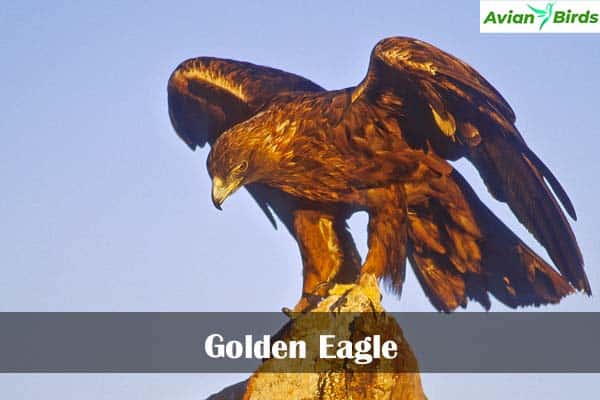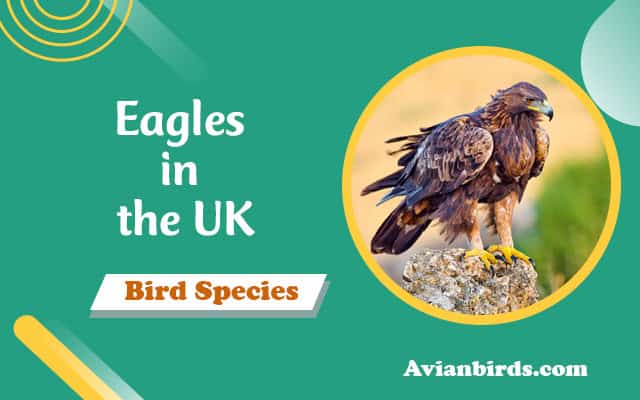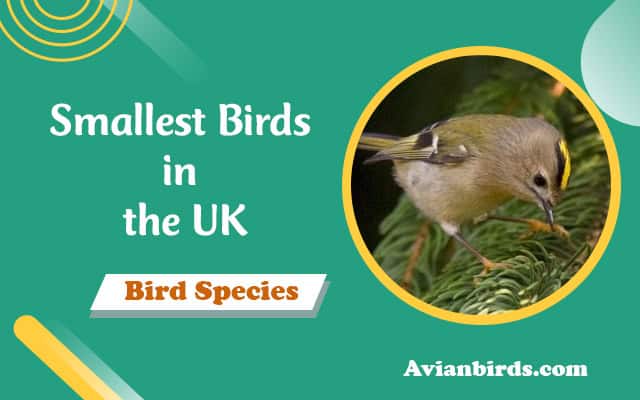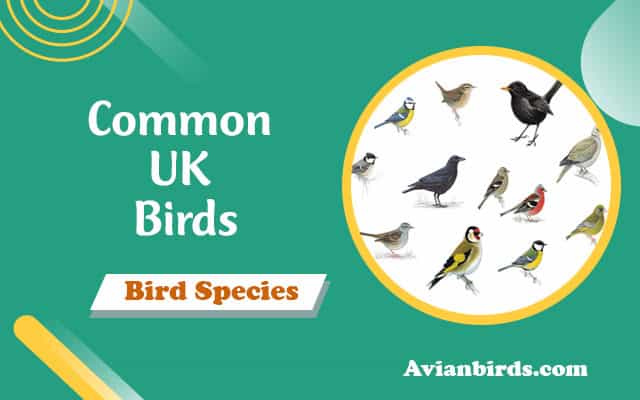Eagles in the UK (ID Guide With Pictures)
Did you know the UK has over 400,000 raptors? This includes the majestic eagles, the top bird predators. We explore the world of eagles in the UK, finding many species with unique traits and stunning looks.
Our bird identification guide will help you learn and love these amazing birds. With detailed pictures and key details, we invite you to explore the eagles of the UK. This will make birdwatching better for both new and experienced birdwatchers.
Introduction to Eagles in the UK
Eagles are amazing birds that play a big role in our world. They are at the top of the food chain. This helps keep the balance in nature. Eagles in the UK have a long history and are very important to our environment.
Long ago, eagles were everywhere in the UK. They were seen as symbols of strength and power. But now, their homes are gone, and their numbers have dropped. This has led to efforts to save these birds and bring back their numbers.
We will look at the different types of eagles in the UK. We will talk about what makes them special and where they live. Our goal is to make people curious and appreciate these birds. We want to help everyone understand how important they are to our planet.
| Aspect | Details |
|---|---|
| Role in Ecosystem | Apex predators help control prey populations. |
| Historical Presence | Widespread across the UK, significant cultural symbol. |
| Current Challenges | Habitat loss, hunting, environmental changes. |
| Conservation Status | Ongoing efforts to restore populations and protect habitats. |
Types of Eagles in the UK
In the UK, we find two main eagle species: the Golden Eagle and the White-tailed Eagle. Each has its own look and home, making them even more amazing. We’ll also look at some less common eagles that add to the variety.
1. Golden Eagle
- Scientific Name: Aquila chrysaetos
- Size: 66–102 cm
- Wingspan: 1.8–2.34 m
- Weight: 3–6.35 kg
- Lifespan: 15–30 years
- Diet: Carnivorous (mammals, birds, reptiles)
The Golden Eagle is known for its big wings and great hunting skills. It lives in the Scottish Highlands, where it loves the rough terrain and lots of food. Young eagles have mottled brown feathers that turn dark as they grow up.

These eagles like to be alone, but they pair up when it’s time to have babies. They show off their strength and beauty as they fly through the mountains.
2. White-tailed Eagle
- Scientific Name: Haliaeetus albicilla
- Size: 66–94 cm
- Wingspan: 1.78–2.45 m
- Weight: 3.1–6.9 kg
- Lifespan: 20–25 years
- Diet: Carnivorous (fish, birds, small mammals)
The White-tailed Eagle is one of the biggest eagles in the world. It’s found near the coast and rivers in the UK. Its white tail feathers make it easy to spot.

These eagles are great at catching fish and small animals. They glide over water with ease. Their return from being almost gone has made us appreciate them even more.
Other Lesser-Known Species
There are also some less common eagles in the UK. The Lesser Spotted Eagle is rare but can be seen in woodlands and wetlands during migration. Each eagle plays a part in keeping the ecosystem balanced.
Learning about these different eagles helps us value the wildlife around us. It shows how diverse and rich our environment is.
| Species | Wingspan | Habitat | Main Diet |
|---|---|---|---|
| Golden Eagle | 6-7.5 feet | Scottish Highlands | Small mammals, birds |
| White-tailed Eagle | 6.5-8 feet | Coastal regions, river estuaries | Fish, small mammals |
| Lesser Spotted Eagle | 4.5-5.5 feet | Woodlands, wetlands | Small mammals, reptiles |
Eagles Population UK: Current Statistics
Looking into the eagle population in the UK gives us interesting facts. We track eagle numbers to see how they’ve changed over time. Some eagle species are doing well, but others face big challenges.
Population Trends Over the Years
In the last few decades, eagle numbers have changed a lot. Thanks to conservation, some eagles, like the White-tailed Eagle, are coming back. In Scotland, their numbers are growing, which is good news.
The Golden Eagle is also doing well. But, some areas are seeing eagle numbers drop. This is due to lost habitats and human actions. We need to keep watching eagle numbers to help them grow.
Geographic Distribution
The eagles in the UK live in different places. Scotland has the most eagles, with both Golden and White-tailed Eagles. Wales and England also have important habitats for eagles. Each place has its own special conditions for eagles.
Our study shows important details about eagle habitats:
| Region | Species Present | Population Estimate |
|---|---|---|
| Scotland | Golden Eagle, White-tailed Eagle | Over 1,500 |
| Wales | White-tailed Eagle | Estimated 100 |
| England | Golden Eagle (rare), White-tailed Eagle | Less than 100 |
Where to See Eagles in the UK
If we love adventure and want to see eagles, we have great places to go. The UK is full of spots where we can watch eagles. Scotland is a top choice, with its Golden Eagles flying over the Highlands.
The Isle of Skye is also amazing for eagle watching. Places like the Fairy Pools and the Cuillin mountains are perfect.
Wales is another great place for eagle-watching. Pembrokeshire’s coast is home to White-tailed Eagles. They can be seen flying over the cliffs.
Brecon Beacons National Park is perfect for hiking and eagle watching. It offers beautiful views and the chance to see eagles.
For the best eagle watching, visit during early mornings or late afternoons. Bring binoculars, a field guide, and a camera. This makes the experience even better.
Whether hiking or having a picnic, eagle watching makes our trips exciting. Scotland and Wales offer unforgettable wildlife adventures.
Eagles Habitat UK: Understanding Their Environment
It’s key to know about eagles’ homes in the UK to help them survive. These birds live in different places where they can breed, eat, and nest. We need to look at where they like to live and the big problem of losing their homes.
Preferred Habitats and Ecosystems
Eagles like big, quiet places with lots of food and good spots to nest. Their favorite homes include:
- Mountains and high places
- Coastal areas with fish
- Forests for shelter and nesting
- Wetlands for a wide variety of food
These places are crucial because they give eagles the food they need. This is important for both grown eagles and young ones as they grow.
Impact of Habitat Loss
Habitat loss is a big problem for eagles in the UK. Cities and farms take over their homes. Climate change makes things worse by changing where food is found. We must act to save eagle homes and keep these amazing birds safe.
Eagles Nesting Habits UK
Learning about eagles nesting habits in the UK helps us understand their breeding ways. These birds pick special places to make their nests. This choice affects their success in raising young and their overall health.
Nesting Locations and Structures
Eagles like to nest in safe spots with a great view. They often choose:
- Tree tops: Tall trees offer good cover and height.
- Cliffs: Rocky cliffs protect them from predators.
- Man-made structures: Some eagles nest on tall pylons or buildings.
Their nests are big and made from sticks, grasses, and more. Built over years, they can grow really big, sometimes over six feet wide.
Must Read: Smallest Birds in the UK
Breeding Seasons and Patterns
The breeding time for eagles changes with the species and area. In the UK, it starts in late winter to early spring. During courtship, eagles show off in the air and call to each other.
After laying eggs, both parents take turns incubating them for 35 to 45 days. The eaglets then rely on their parents for food and safety for a few weeks.
This cycle of courtship, nesting, and raising young is key for eagle conservation. Watching these behaviours helps us understand their needs. This way, we can support their survival in the UK.
Conservation of Eagles UK
The UK’s eagles face many challenges. We learn about these threats to understand how to save them. Illegal hunting, habitat loss, and climate change are big dangers. We must all work together to protect these birds.
Threats Facing Eagle Populations
Several key factors threaten eagles in the UK. Notable threats include:
- Illegal hunting and poaching, targeting both adults and eggs.
- Habitat destruction due to urbanization and agricultural expansion.
- Climate change affects food availability and nesting sites.
- Pollution leads to health issues in eagle populations.
Successful Conservation Efforts
Many groups and governments are working to save eagles. They have started eagle conservation efforts. Some of these successful initiatives include:
| Organization | Campaign/Project | Outcome |
|---|---|---|
| Royal Society for the Protection of Birds | White-tailed Eagle Reintroduction | Successful breeding and increase in population in Scotland. |
| Natural England | Eagle Monitoring Program | Improved awareness and protection measures for nesting sites. |
| Scottish Natural Heritage | Golden Eagle Conservation Strategy | Stabilized population numbers through habitat preservation. |
Eagles Protection Programs UK
The UK is dedicated to saving eagles. Many programs have been set up to help. These efforts improve eagle homes, follow laws, and get people involved. It’s great to see how the government and people work together to protect these birds.
Government Initiatives
The UK government is key in saving eagles. They have many programs to help eagles survive. These include:
- Legal protection of eagle species under the Wildlife and Countryside Act.
- Habitat restoration projects that focus on creating and maintaining environments conducive to eagle breeding.
- Monitoring populations to track changes and respond to potential threats swiftly.
Community Involvement in Conservation
People are important in saving eagles. They help in many ways. For example:
- Citizen science programs, where volunteers assist in data collection and monitoring efforts.
- Local education campaigns to raise awareness about the importance of eagle conservation.
- Collaboration with local organizations that focus on wildlife protection and habitat management.
By working together, we can make a big difference. This helps eagles and benefits us all.
| Initiative Type | Description | Impact |
|---|---|---|
| Legal Framework | Enforcement of protection laws for eagle species. | Prevents poaching and habitat destruction. |
| Research Programs | Studies aimed at understanding eagle behaviours and populations. | Informs better protective measures and policies. |
| Community Workshops | Engagement initiatives to educate communities on eagle conservation. | Encourages local stewardship and support for eagle habitats. |
Photographic Guide to Eagles in the UK
Exploring eagles in the UK is amazing. A photo guide is very helpful. It shows us how to tell different eagles apart. This helps us enjoy watching them more.
We can look at some eagle photos. Each photo shows special things to notice. This is great for those who love birds and nature. Here’s a table with some eagle species and what makes them unique:
| Species | Wingspan | Colouring | Key Identification Features |
|---|---|---|---|
| Golden Eagle | 6-7.5 ft | Dark brown with golden nape | Long wings, large feet |
| White-tailed Eagle | 6-8 ft | Brown with white tail feathers | Distinctive large bill, broad wings |
| Red Kite | 5.5-6 ft | Chestnut brown, pale tips | Forked tail, agile flight |
Getting good eagle photos takes time and skill. Here are some tips:
- Use a long lens to keep a safe distance.
- Find a hidden spot or use camouflage.
- Look for eagles during feeding and nesting times.
Sharing eagle photos helps us show their beauty. It also helps in protecting them. By doing this, we help eagles thrive in the UK.
How to Identify Eagles in the UK
Spotting eagles in the UK is exciting for bird watchers and nature fans. Each eagle has unique features. We can tell them apart by looking at their size, colour, wing shape, and sounds.
Key Identification Features
There are key traits to help us spot eagles in the UK. These include:
- Size: Eagles come in different sizes. The White-tailed Eagle is huge, with a wingspan up to 8 feet. The Golden Eagle has a wingspan of about 6 to 7 feet.
- Plumage Coloration: Their feathers can look very different. Young eagles may look different from adults. Adult Golden Eagles are dark brown, while White-tailed Eagles are lighter and more mottled.
- Wing Shape: The shape and size of their wings help us tell them apart. Golden Eagles have long, narrow wings. White-tailed eagles have broader wings and white feathers at the tail.
- Calls and Vocalizations: Hearing their calls is important. Golden Eagles make a low, melodious sound. White-tailed Eagles have a higher, repetitive call.
Differences Between Species
Knowing the differences between eagle species helps us identify them in the UK. Here’s a table that shows some key differences:
| Feature | Golden Eagle | White-tailed Eagle |
|---|---|---|
| Wingspan | 6-7 feet | Up to 8 feet |
| Plumage | Dark brown, golden nape | Light mottled with white tail |
| Flight Style | Agile, soaring | Heavy, flapping |
| Habitat Preference | Mountainous and open areas | Coastal areas, estuaries |
Interesting Facts About Eagles in the UK
Eagles are very important in the UK’s culture. They make people feel amazed and grateful. Let’s look at some cool facts about their role and the myths around them.
Cultural Significance
In the UK, eagles are seen in art and symbols. They stand for strength, courage, and freedom. Eagles are also big in old stories, seen as protectors of the sky. They are key figures in British myths.
Myths and Legends
For centuries, eagles have been part of many myths. In some stories, they carry messages from the gods. Others say eagles can see the future, adding to their mystery. These tales show how much people admire eagles.
| Aspect | Description |
|---|---|
| Cultural Representation | Eagles are symbols in art and national emblems |
| Folklore | Featured as guardians and messengers in various tales |
| Strength and Freedom | Represent attributes like courage and independence |
| Connection to the Spiritual | Believed to carry messages from the heavens |
Conclusion
We’ve looked at eagles in the UK and their important role in our ecosystem. We’ve seen how eagles like the Golden Eagle and White-tailed Eagle live and thrive. This knowledge helps us understand why we must protect them.
Eagles are more than just beautiful birds. They are key to keeping our environment healthy. We should all help protect eagles and their homes. This means supporting efforts to keep their habitats safe.
Working together, we can make sure eagles stay in the UK skies for years to come. Let’s work to keep their homes healthy. And let’s celebrate the special place eagles hold in our culture.
Read More🦅 Related Articles:
Frequently Asked Questions
Q1. Where can I see eagles in the UK?
You can spot eagles in places like the Scottish Highlands, Isle of Mull, and Isle of Skye.
Q2. What eagles are native to the UK?
The native eagles in the UK are the golden eagle and white-tailed eagle.
Q3. How rare are golden eagles in the UK?
Golden eagles are relatively rare, with about 500 breeding pairs, mostly in Scotland.
Q4. When is the best time to spot eagles in Scotland?
The best time to spot eagles in Scotland is during the summer, especially from April to August.
Q5. Are there white-tailed eagles in England?
Yes, white-tailed eagles have been reintroduced in southern England, particularly on the Isle of Wight.
Q6. How many species of eagles live in the UK?
Two species live in the UK: the golden eagle and the white-tailed eagle.
Q7. What is the largest eagle in the UK?
The white-tailed eagle is the largest eagle in the UK, with a wingspan of up to 2.5 meters.
Q8. How do I identify an eagle in the UK?
Eagles can be identified by their large size, broad wings, and soaring flight. White-tailed eagles have pale heads and tails, while golden eagles have dark brown feathers with a golden hue on the head.
Q9. Where do golden eagles nest in the UK?
Golden eagles typically nest in remote areas of the Scottish Highlands, on cliffs or tall trees.
Q10. How protected are eagles in the UK?
Eagles are fully protected under UK law, with strict measures in place to protect their habitats and prevent persecution






